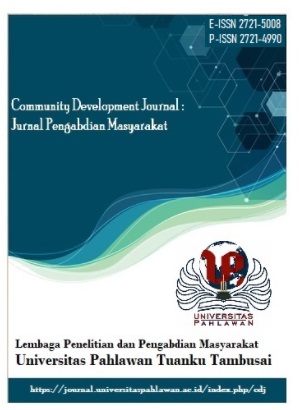TEACHING SIMPLE PRESENT TENSE THROUGH COLLABORATIVE WAYS: INDUCTIVE INSTRUCTION AND LOCAL CONTENT BASED LESSON AT THE FIRST SEMESTER STUDENTS
DOI:
https://doi.org/10.31004/jrpp.v6i3.26644Keywords:
Effective, Simple Present Tense, Collaborative WaysAbstract
This research aimed to find out whether the implementation of Inductive Instruction and Local Content Based Lesson as the collaborative way in teaching Simple Present Tense (SPT) was effective or not. The research was done at English Education Study Program at the first semester students who took Grammar in Written Discourse Subject with one to one class pretest-posttest. The instruments were the result of pretest and posttest consisted of 20 numbers of multiple-choice questions. The researchers analyzed the data through SPSS application. The researchers found that, the percentage of mean N gain score is 76.52% which is more than 76% the standard percentage of interpretation data and the mean score in pre-test (50.57) and post-test is (87.50). To see how effective these ways to teach Simple Present Tense and also to prove the result of hypotheses testing, the researchers used the result of Sig 2-tailed. It is obtained that the value sig 2-tailed (0,000) is less than the value of . So, finally, Ho is rejected and Ha is accepted.References
Ary, et all. (2010). Introduction to Research in Education. Wadsworth: Cengage Learning.
Brown, H. D. (1994). Teaching by principles: An interactive approach to language pedagogy. Englewood Cliffs, NJ: Prentice Hall Regents.
Cresswell, J.W. (2012). Educational research; planning, conducting, and evaluating quantitative and qualitative research (4th edition).New York: Pearson.
Fischer, A. R. (1979). The inductive-deductive controversy revised. Modern Language Journal, 63(3), 98-105.
Gay, L.R, Mills, G.E., & Airasian, P. W. 2012. Educational Research: competencies for analysis and application. Tenth edition. Upper saddle River, New York: Pearson Merril Prentice Hall.
Paradowski, Micha? B. (2007) Exploring the L1/L2 Interface. A Study of Polish Advanced EFL Learners. Institute of English Studies, University of Warsaw
Pontarolo, G. (2013). The role of grammar in EFL instruction: A study on secondary school students and teachers. Unpublished master’s thesis, University of Padova, Italy.
Rattanaphumma, R. 2006. Community-Based English Course in Local Perspectives. Conferences, symposia and Campus Events. Chulalongkorn University: 392-401.
Raymond Murphy, Essential Grammar in Use, Cambridge University Press, Second Edition 1990.
Richards, J.C. and Schmidt,R. 2010. Longman dictionary of language teaching and applied.
Sugiyono. 2007. Metode Penelitian Kuantitatif Kualitatif dan R&D. Bandung: Alfabeta.
Thornbury, Scott. How to Teach Grammar. London: Pearson Education Limited, 1999.
Wang, Haoge. Deductive vs Inductive Teaching Approaches to EFL Grammar Instruction: A Case Study of Chinese High School. The Dissertation, 2012.
Wei, Y. (2005). Integrating Chinese Culture with TEFL in Chinese Classroom. Sino-US
English Teaching, 2(7), 55-58
Yeny, P. (2013). Transmitting Local Cultural Knowledge through English as Foreign Language (EFL) Learning as a Means of Fostering “Unity in Diversity”. E-ISSN, 2281-4612. Doi:10.5901/ajis.2013.v2n3p507.
Downloads
Published
How to Cite
Issue
Section
License
Copyright (c) 2023 Yulina Tiwery

This work is licensed under a Creative Commons Attribution-ShareAlike 4.0 International License.






